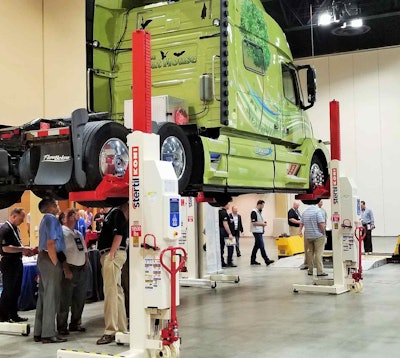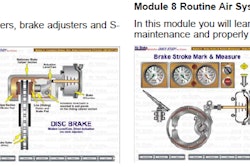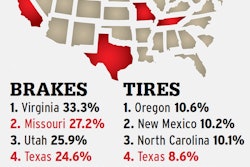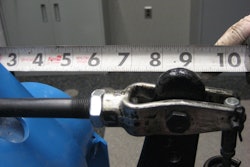I first met Kenn and Beth Zelten about three years ago. Their professional approach to business and personal interactions was instantly apparent. Kenn started driving in the Army in 1971 and, after returning home, began his trek in commercial driving. Beth joined Kenn driving in 1989 – they’ve operated with their own authority and as contractors since.
 Kenn and Beth Zelten’s Volvo up on the lift for attendees of the CVSA’s recent brake-safety symposium.
Kenn and Beth Zelten’s Volvo up on the lift for attendees of the CVSA’s recent brake-safety symposium.Now leased to Landstar, the Michigan Upper Peninsula-based team not only attended the Commercial Vehicle Safety Alliance brake-training symposium in Schaumburg, Illinois, last month; they took their 2015 Volvo tractor to the event, where CVSA instructors used it to educate inspectors and others in attendance. Having 150 or so pairs of eyes combing the underside of the truck for two days might be one unsettling “out of truck experience,” so to speak, for most of us.
But Kenn and Beth were excited for the opportunity. (As the date approached they told me they were attempting to locate a small but pesky air leak, wanting to make the best impression possible at the event. My experience with them is that this meticulous attention to detail is nothing new. And yes, they did find it and repair it just in the nick of time.)
Their Volvo features some forward-leaning tech: the I-Shift transmission, an adaptive load system with a liftable tag axle on the front pair of the tandems, wide-base single drive tires and Doran tire monitoring system, several aerodynamic add-ons and solar battery charging.
The features brake-symposium attendees were most interested in: disc brakes on the front axle, drum brakes on the rears, allowing an opportunity for more thorough training.
With their Volvo perched high off the ground, the Zeltens watched, listened and learned, wanting what Kenn described as “usable takeaway information.”
Not all disc brake systems are the same. The Meritor system on the Zeltens’ truck has a dust cover virtually preventing a visual inspection, so they’ve learned to listen for a knock-knock sound and watch for a wobble of the caliper. The system has a small plastic measurement indicator that helps drivers to know the condition of their brakes.
One of the more important things learned: proper brake inspections should be conducted at an air pressure of 90 lbs., something neither of us knew. Just why became clear when we thought about the need for consistent measurements to best insure proper brake performance in highway conditions. Higher air pressures could mask a potential adjustment issue.
And when the automatic in automatic slack adjusters isn’t meaning exactly what it says? While most owners will choose to adjust an auto slack that is out of compliance, CVSA prefers that they be replaced. Opinions are plentiful, so what’s the correct answer?
Making a brake adjustment in an auto slack may not correct a problem if there is a bigger, underlying problem with the brake system. Here is where a properly trained, advanced technician certified to inspect and diagnose brake issues can be a valuable ally.
We can learn from the results, also. The last several years, CVSA air-brake-focused inspection events have found 13-15 percent of vehicles’ brakes out of adjustment compliance. During the 2017 Roadcheck event, braking-system violations were as usual the top reason vehicles were placed out of service. Let it serve as a strong reminder that there’s no substitute for preventive maintenance. The ability to stop as quickly as possible is crucial to our own safety, and that of those around us.











